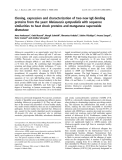
Eczema and dermatitis
-
Malassezia sympodialisis an opportunistic yeast that col-onizes human skin and may induce IgE and T cell reac-tivity in patients with atopic eczema/dermatitis syndrome (AEDS). Previously, we have cloned and expressed six recombinant allergens (rMala s 1 and rMala s 5 to rMal-a s 9) from this yeast. By combining high throughput screening and phage surface display techniques, 27 com-plete and partial IgE-binding clones of M. sympodialis have been identified. Here we enlarged the panel of recombinant M.
 10p
10p  dell39
dell39
 03-04-2013
03-04-2013
 39
39
 2
2
 Download
Download
-
Acne Vulgaris Acne vulgaris is a self-limited disorder primarily of teenagers and young adults, although perhaps 10–20% of adults may continue to experience some form of the disorder. The permissive factor for the expression of the disease in adolescence is the increase in sebum production by sebaceous glands after puberty. Small cysts, called comedones , form in hair follicles due to blockage of the follicular orifice by retention of keratinous material and sebum.
 5p
5p  konheokonmummim
konheokonmummim
 30-11-2010
30-11-2010
 74
74
 4
4
 Download
Download
-
Acne Rosacea Acne rosacea, commonly referred to as rosacea, is an inflammatory disorder predominantly affecting the central face. Those most often affected are Caucasians of northern European background, but it is seen in patients with dark skin also.
 5p
5p  konheokonmummim
konheokonmummim
 30-11-2010
30-11-2010
 94
94
 4
4
 Download
Download
-
Dermatophytosis: Treatment Both topical and systemic therapies may be used to treat dermatophyte infections. Treatment depends on the site involved and the type of infection. Topical therapy is generally effective for uncomplicated tinea corporis, tinea cruris, and limited tinea pedis. It is not effective as a monotherapy for tinea capitis or onychomycosis. Topical imidazoles, triazoles, and allylamines may be effective therapies for dermatophyte infections, but nystatin is not active against dermatophytes.
 5p
5p  konheokonmummim
konheokonmummim
 30-11-2010
30-11-2010
 85
85
 6
6
 Download
Download
-
Candidiasis: Treatment Treatment involves removing any predisposing factors such as antibiotic therapy or chronic wetness and the use of appropriate topical or systemic antifungal agents. Effective topicals include nystatin or azoles (miconazole, clotrimazole, econazole, or ketoconazole). The associated inflammatory response accompanying candidal infection on glabrous skin can be treated with a mild glucocorticoid lotion or cream (2.5% hydrocortisone).
 5p
5p  konheokonmummim
konheokonmummim
 30-11-2010
30-11-2010
 94
94
 4
4
 Download
Download
-
Lichen Planus Lichen planus (LP) is a papulosquamous disorder that may affect the skin, scalp, nails, and mucous membranes. The primary cutaneous lesions are pruritic, polygonal, flat-topped, violaceous papules. Close examination of the surface of these papules often reveals a network of gray lines (Wickham's striae). The skin lesions may occur anywhere but have a predilection for the wrists, shins, lower back, and genitalia (Fig. 53-5).
 5p
5p  konheokonmummim
konheokonmummim
 30-11-2010
30-11-2010
 90
90
 4
4
 Download
Download
-
Ecthyma is a variant of impetigo that causes punched-out ulcerative lesions. It may result from neglected or inadequately treated impetigo. Treatment of both ecthyma and impetigo involves gentle debridement of adherent crusts, which is facilitated by the use of soaks and topical antibiotics, in conjunction with appropriate oral antibiotics. Furunculosis is also caused by S. aureus, and this disorder has gained prominence in the last decade because of CA-MRSA. A furuncle, or boil, is a painful, erythematous, nodule that can occur on any cutaneous surface.
 5p
5p  konheokonmummim
konheokonmummim
 30-11-2010
30-11-2010
 90
90
 4
4
 Download
Download
-
Guttate psoriasis (eruptive psoriasis) is most common in children and young adults. It develops acutely in individuals without psoriasis or in those with chronic plaque psoriasis. Patients present with many small erythematous, scaling papules, frequently after upper respiratory tract infection with β-hemolytic streptococci. The differential diagnosis should include pityriasis rosea and secondary syphilis. Pustular psoriasis is another variant. Patients may have disease localized to the palms and soles, or the disease may be generalized.
 6p
6p  konheokonmummim
konheokonmummim
 30-11-2010
30-11-2010
 75
75
 4
4
 Download
Download
-
The evidence implicating psoriasis as a T cell–mediated disorder has directed therapeutic efforts to immunoregulation. Cyclosporine and other immunosuppressive agents can be very effective in the treatment of psoriasis, and much attention is currently directed toward the development of biologic agents with more selective immunosuppressive properties and better safety profiles (Table 53-4). Experience with these agents is limited and information regarding combination therapy and adverse events continues to emerge.
 5p
5p  konheokonmummim
konheokonmummim
 30-11-2010
30-11-2010
 95
95
 4
4
 Download
Download
-
Psoriasis (Table 53-2) Psoriasis is one of the most common dermatologic diseases, affecting up to 1% of the world's population. It is a chronic inflammatory skin disorder clinically characterized by erythematous, sharply demarcated papules and rounded plaques, covered by silvery micaceous scale. The skin lesions of psoriasis are variably pruritic. Traumatized areas often develop lesions of psoriasis (Koebner or isomorphic phenomenon). Additionally, other external factors may exacerbate psoriasis including infections, stress, and medications (lithium, beta blockers, and antimalarials).
 5p
5p  konheokonmummim
konheokonmummim
 30-11-2010
30-11-2010
 84
84
 5
5
 Download
Download
-
Stasis dermatitis. An example of stasis dermatitis showing erythematous, scaly, and oozing patches over the lower leg. Several stasis ulcers are also seen in this patient. Stasis Dermatitis and Stasis Ulceration: Treatment Patients with stasis dermatitis and stasis ulceration benefit greatly from leg elevation and the routine use of compression stockings with a gradient of at least 30–40 mmHg. Stockings providing less compression, such as antiembolism hose, are poor substitutes.
 5p
5p  konheokonmummim
konheokonmummim
 30-11-2010
30-11-2010
 96
96
 4
4
 Download
Download
-
Lichen Simplex Chronicus Lichen simplex chronicus may represent the end stage of a variety of pruritic and eczematous disorders, including atopic dermatitis. It consists of a circumscribed plaque or plaques of lichenified skin (thickening of the skin and accentuation of normal skin markings) due to chronic scratching or rubbing. Common areas involved include the posterior nuchal region, dorsum of the feet, and ankles. Treatment of lichen simplex chronicus centers on breaking the cycle of chronic itching and scratching.
 5p
5p  konheokonmummim
konheokonmummim
 30-11-2010
30-11-2010
 74
74
 7
7
 Download
Download
-
Dyshidrotic eczema. This example is characterized by deep-seated vesicles and scaling on palms and lateral fingers, and the disease is often associated with an atopic diathesis. The evaluation of a patient with hand eczema should include an assessment of potential occupation-associated exposures. The history should be directed to identifying possible irritant or allergen exposures.
 5p
5p  konheokonmummim
konheokonmummim
 30-11-2010
30-11-2010
 105
105
 7
7
 Download
Download
-
Harrison's Internal Medicine Part 2. Cardinal Manifestations and Presentation of Diseases Section 9. Alterations in the Skin Chapter 53. Eczema, Psoriasis, Cutaneous Infections, Acne, and Other Common Skin Disorders Eczema and Dermatitis Eczema and Dermatitis: Introduction Eczema is a type of dermatitis and these terms are often used synonymously (atopic eczema or atopic dermatitis). Eczema is a reaction pattern that presents with variable clinical findings and the common histologic finding of spongiosis (intercellular edema of the epidermis).
 5p
5p  konheokonmummim
konheokonmummim
 30-11-2010
30-11-2010
 521
521
 7
7
 Download
Download
-
Figure 53-1 Atopic dermatitis. Hyperpigmentation, lichenification, and scaling in the antecubital fossae are seen in this patient with atopic dermatitis. (Courtesy of Robert Swerlick, MD; with permission.) Atopic Dermatitis: Treatment Therapy of AD should include avoidance of cutaneous irritants, adequate moisturizing through the application of emollients, judicious use of topical antiinflammatory agents, and prompt treatment of secondary infection. Patients should be instructed to bathe no more often than daily using warm or cool water, and to use only mild bath soap.
 5p
5p  konheokonmummim
konheokonmummim
 30-11-2010
30-11-2010
 83
83
 5
5
 Download
Download
CHỦ ĐỀ BẠN MUỐN TÌM



























